Stade de Reims’ solid defending may have been the most impressive aspect of their game throughout the 2019/20 campaign. When Ligue 1 was cancelled back in April, they had the best defensive record in France’s top tier, conceding just 21 goals in 28 games – three fewer goals than Rennes and PSG, respectively, both of whom qualified for next season’s UEFA Champions League via their league positions. This impressive defensive record helped them to secure a sixth-place finish on the 2019/20 Ligue 1 table.
Hassane Kamara was Reims’ main left-back throughout the 2019/20 season and as such, played an important part in Reims’ solid defence, however, he departed from the club earlier this summer to join OGC Nice, who finished one place above Reims via head-to-head points.
Les Rouges et Blancs dipped into the transfer market and signed 22-year-old left-back Thibault De Smet from Belgian side Sint-Truidense VV and in this tactical analysis piece, we will provide a scout report on De Smet and we will attempt to determine how he may fit into David Guion’s tactics this coming season.
The left-back’s role within Reims’ tactics last season
Reims didn’t out to be a particularly possession-based side last season, however they did finish in the top half of Ligue 1’s possession table for the 2019/20 campaign, keeping the eighth-highest average percentage of possession in France’s top-tier – 50.3%.
During the build-up, Reims tended to play more cautiously and they picked their passes more carefully, however when the ball progressed to the middle and final thirds of the pitch, Les Rouges et Blancs became more direct and progress quickly towards the opposition penalty area.
While Reims only played the 12th-highest number of passes per 90 in Ligue 1 last season (386.38), they played the sixth-highest number of deep completions (a pass received within a 20m radius of the opposition goal-line, excluding crosses) per 90 (7.07) and the fourth-highest number of through passes per 90 (8.48), indicating that they played quite a direct passing game and were constantly trying to break through the opponent’s defensive line in possession.
During the build-up, Reims’ left-back, generally Kamara, tended to push quite high up the wing, essentially providing the offensive width on the left-hand side of the pitch.
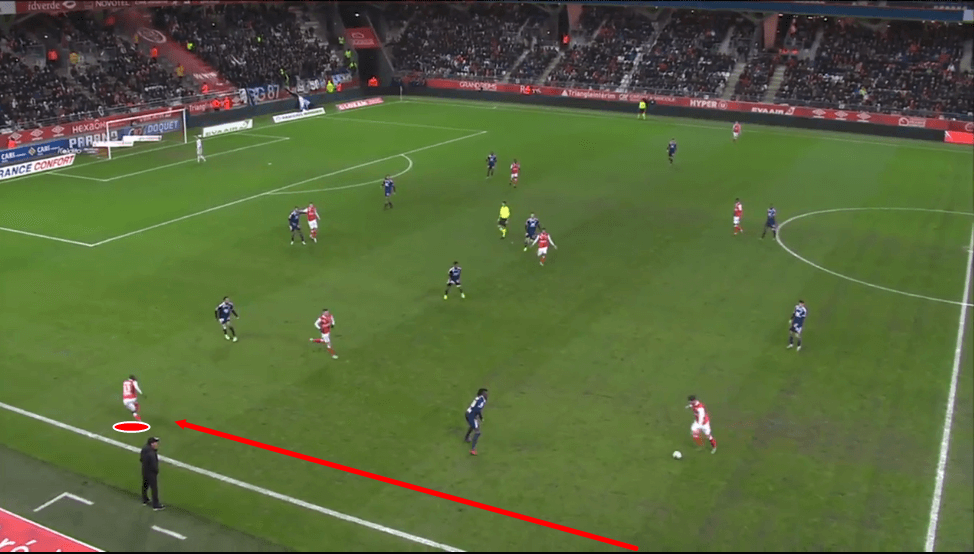
We can see an example of Kamara occupying this position during a particularly advanced phase of Reims’ build-up in the image above. The left-back combines with Reims’ left-winger to create a 2v1 situation versus the opposition right-back on this occasion and the deep ball-carrier can pick out the left-back’s run via a long-ball as a result.
As we can see, within Guion’s tactics during the build-up last season, Reims’ left-back was required to sit high, make offensive runs and demonstrate plenty of pace to get in behind the opposition’s defensive line.
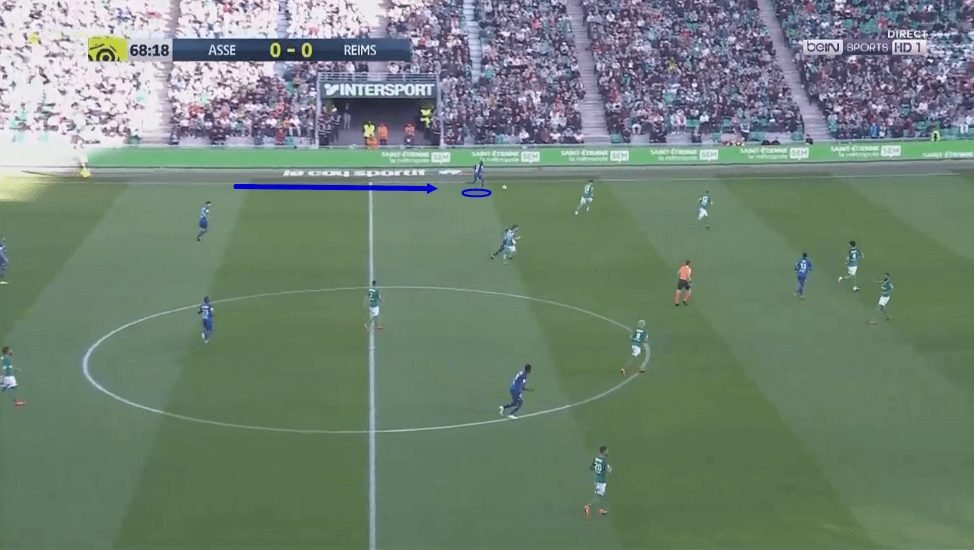
If not getting onto the receiving end of a progressive pass during the build-up, Reims’ left-back was quite often tasked with carrying the ball from a slightly deeper position after receiving to feet, which we can see an example of in this image above.
Reims attempted the sixth-highest number of dribbles per 90 of any Ligue 1 side last season (29.14) and they had a dribble success percentage of 55% – the highest dribble success rate of any team in France’s top-flight during the most recent campaign.
This shows how important the skill of dribbling was for Les Rouges et Blancs last term and effective dribbling was particularly important for the left-back who was often in a position in which he was required to either receive the ball at pace high up the pitch and carry it past the opposition’s last line of defence or collect the ball in the middle third of the pitch and subsequently carry it into the final third.
It is evident how much Reims relied on their left-wing and Kamara to do this by the fact that 39% of their attacks came down the left flank. That is the highest percentage that any Ligue 1 side attacked down either flank during the 2019/20 campaign.
Furthermore, Kamara’s effectiveness in his role in possession last season is evident by the fact that he completed 3.61 progressive runs per 90 last term – the seventh-highest number of progressive runs per 90 that were completed by any Ligue 1 player during the 2019/20 season.
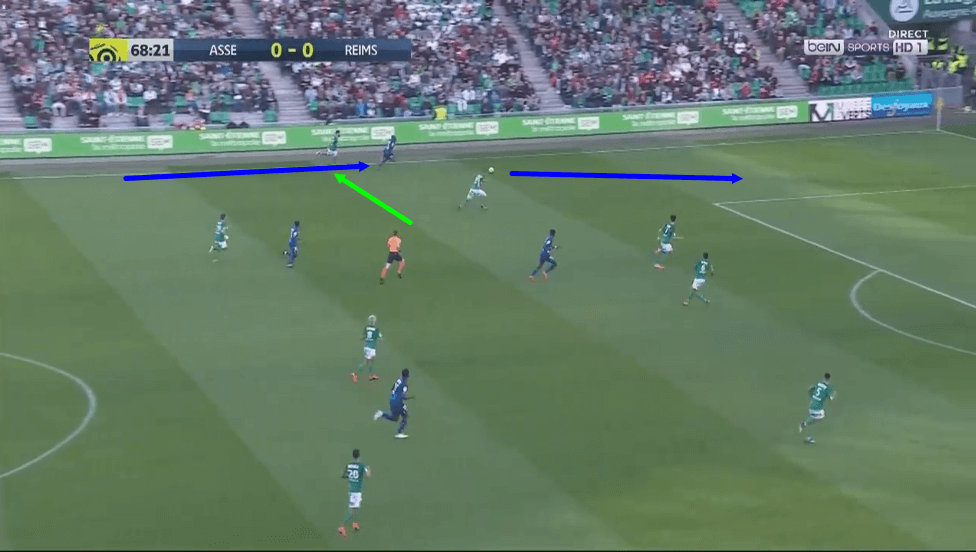
These stats back up how effective Kamara was at progressing the play for Reims last season and this image above provides us with a visual example of the player doing just that. This image follows on from the previous one in which we saw Kamara in possession of the ball near the half-way line and here, we can see that his dribble managed to attract the attention of an opposition player, whom he beats and continues his run down the left flank, carrying the ball into a crossing position.
This, again, shows us how important speed and technical dribbling ability were for Reims’ left-back during the 2019/20 campaign. It may be fair to say that Kamara played an important role for Les Rouges et Blancs in the build-up and in attack thanks to his impressive ability in these areas.
Reims didn’t defend particularly aggressively last season on the whole, however, Kamara was quite an aggressive defender, individually, last term. The left-back engaged in the third-highest number of defensive duels per 90 (8.27) of any Reims player last season and in addition to that, Kamara made the third-highest number of sliding tackles per 90 of any player in the entirety of Ligue 1 (1.68) during the 2019/20 season.
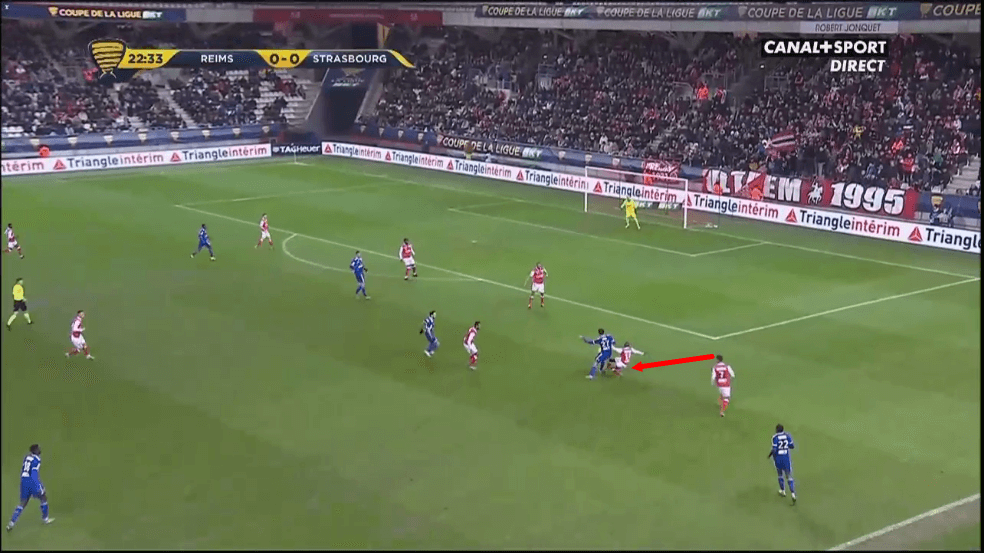
This image above shows us an example of how Kamara liked to defend last season and as we can see, the left-back was aggressive, happy to press out of his team’s defensive line to commit to tackles on opposition players in possession of the ball just in front of Reims’ backline.
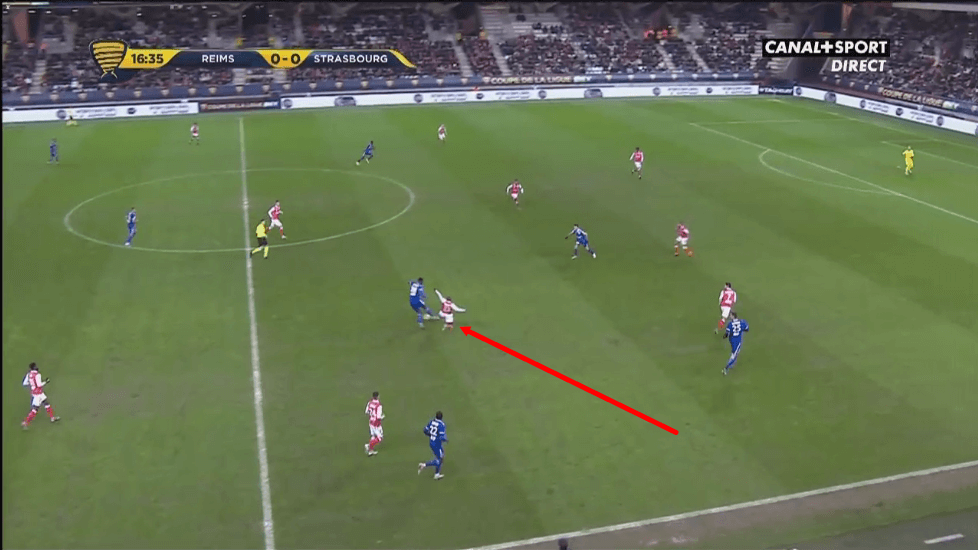
As well as that, Kamara was happy to defend in a similar fashion to how he defended in deep areas of the pitch, in more advanced areas of the pitch, which the image above provides us with an example of.
Here, we can see Kamara charging an opposition player down in the centre of the pitch. Just prior to this image being taken, the left-back was dispossessed by an opposition player and the left-back subsequently followed the play into midfield where he charged down an opposition midfielder and performed a sliding tackle in order to win back possession, thus preventing a counter-attack from occurring.
Lastly, in addition to his aggressiveness and his fondness of making sliding tackles, Kamara’s pace and intelligent reading of the game played a significant role in the defensive side of his game.
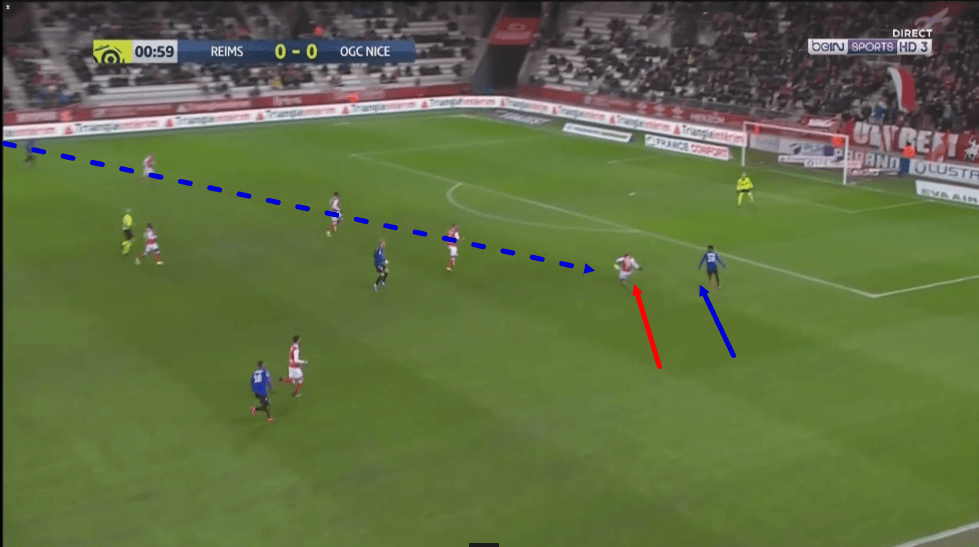
He provided cover for Reims from the left-back position when the opposition attempted to play long-balls in behind the defensive line, as we can see in the image above.
Here, the opposition played a long-ball in an attempt to get in behind Reims’ defensive line, however, the left-back was alert and tracked this runner, while judging the flight of the ball in order to perform an interception that put a stop to the opposition attack.
So, as we can see, the Reims left-back’s aggressiveness and technical tackling ability, in addition to his pace and intelligent reading of the game, played an important role in his effectiveness for Reims off the ball last season and undoubtedly helped him to play an integral part in Ligue 1’s best defence for the 2019/20 season.
This section shows us the important role that Kamara and the left-back position played within Reims’ tactics last season and we will now provide some analysis of De Smet and how he and his attributes may translate to Guion’s system.
De Smet’s positioning
The previous section showed that Kamara played a significant role for Reims at both ends of the pitch last season. The former Reims man demonstrated the ability to have an influence on both the offensive and defensive side of things during the 2019/20 campaign and he excelled in his box-to-box role within Guion’s tactics thanks to his well-rounded attributes.
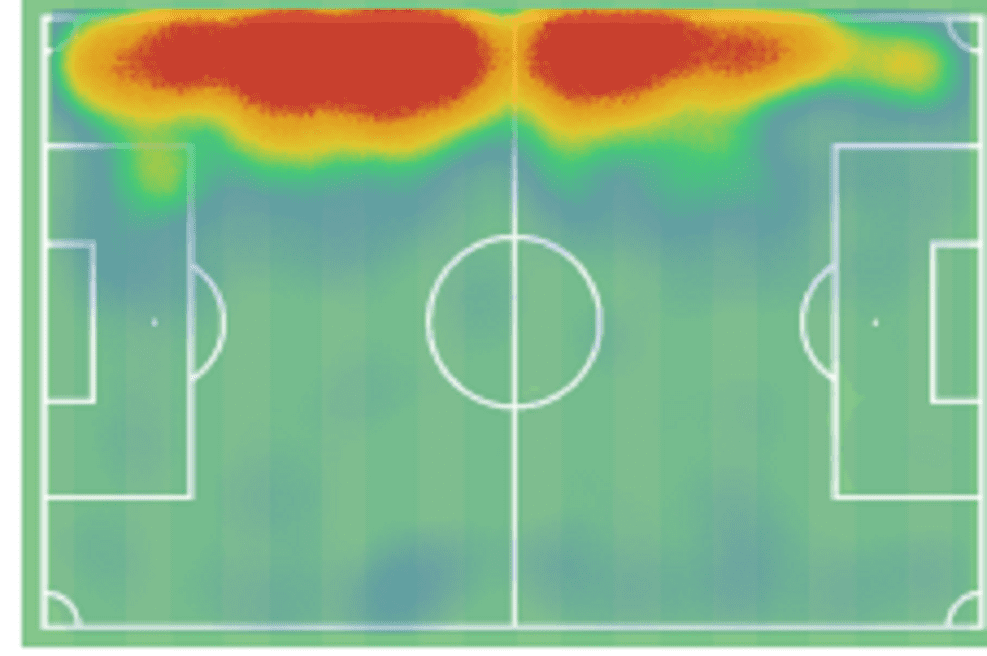
The image above shows us Kamara’s heatmap for the 2019/20 season and this provides us with a visualisation of his box-to-box role and this emphasises just how busy he was and how much energy and effort was required from him to get up and down Reims’ left flank last season.
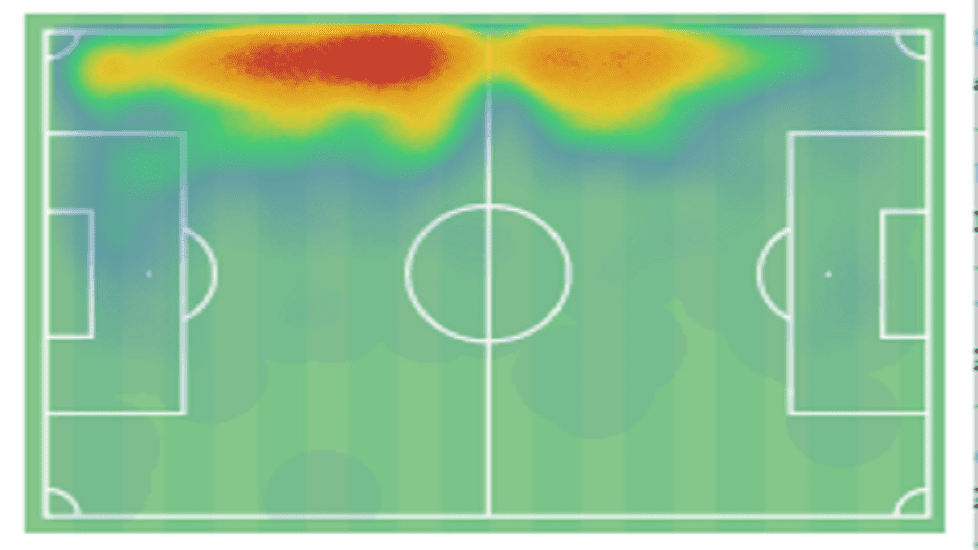
This next image is De Smet’s heatmap for the 2019/20 campaign. As we can see, while the Belgian full-back does get up and down the flank, similarly to Kamara, he spent far less time in the opposition’s half of the pitch last season, compared to the amount of time that Kamara spent in those parts of the pitch.
Furthermore, in addition to that, this image shows us that De Smet didn’t get quite as far forward on the pitch for Sint-Truidense last season as Kamara did for Reims, as the new Reims man didn’t really progress past the middle third of the pitch very frequently at all, as visualised by this heatmap.
De Smet in possession
De Smet differed significantly from Kamara in terms of how he performed when in possession of the ball last season. It’s worth noting that a comparison between how De Smet performed within Sint-Truidense’s tactics and how Kamara performed within Reims’ tactics is never going to be a direct one, however, De Smet’s performances last season do give us an idea about his strengths and weaknesses, what he likes to do and what he doesn’t like to do and we can use his performances last season to try and determine how he may perform within Guin’s tactics and system this coming season.
So, last season, De Smet made 2.0 fewer dribbles per 90, 4.2 fewer offensive duels per 90 and 1.72 fewer progressive runs per 90 than Kamara.
We already touched on how important the left-back’s ball progression was for Reims last season and judging by these statistics, it may be fair to say that it doesn’t appear as though De Smet harbours as much ability as Kamara in that area of the game.
Additionally, while Kamara failed to make a single league assist last term, indicating that he struggled to produce with his final ball, despite thriving as a ball-carrier, it doesn’t appear that De Smet is much better in that regard, as he also made no assists last season and he also made 1.2 fewer crosses per 90 than Kamara last term, with just 0.4% higher cross accuracy than the former Reims man.
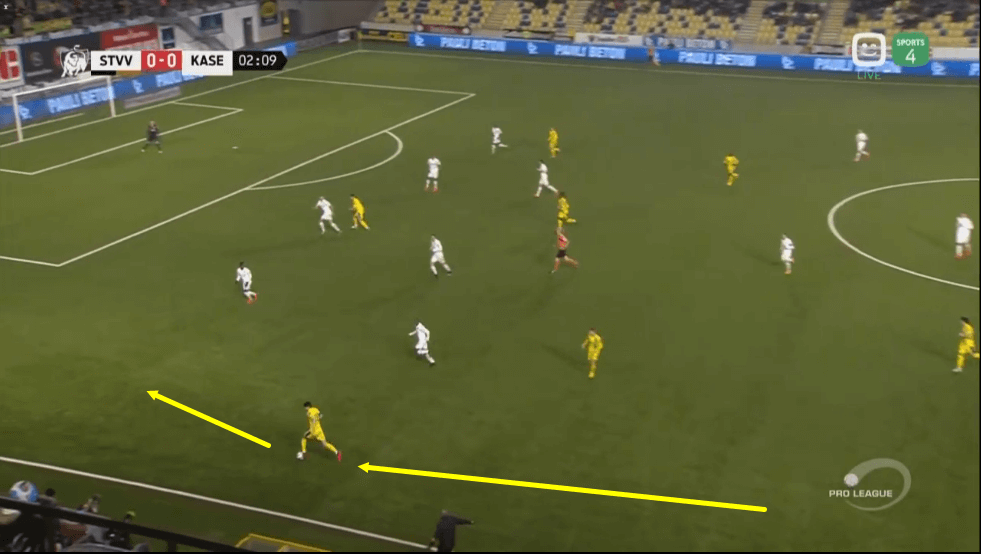
All of this is not to say that De Smet didn’t get forward at all last season. The left-back did contribute to the offensive side of the game for Sint-Truidense, as this image above shows us.
Here, we can see De Smet carrying the ball down the wing from the middle third of the pitch whilst playing against a deep and narrow defensive block. During this particular passage of play, Sint-Truidense were prevented from playing through the centre of the pitch by the opposition’s compact, narrow defensive shape and they were forced to play through the wings, which De Smet facilitated.
It is notable, however, that despite him making this offensive run, in a similar fashion to a run that we saw Kamara making in a previous image during this tactical analysis, the left-back does not draw an opponent’s press.
When Kamara made runs like this for Reims last season, he often attracted opposition players towards him thus creating space for his teammates elsewhere on the pitch, however, that was not the case for De Smet, who the opposition often appeared to be happy to allow space and time on the ball out wide.
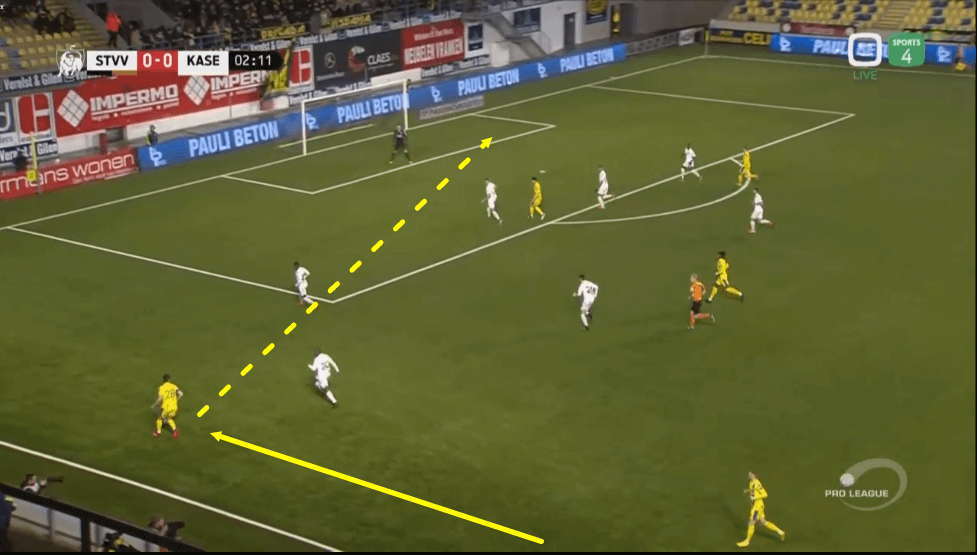
As this particular passage of play moves on, De Smet continues his run, carrying the ball along the wing until he was almost level with the edge of the penalty box, and he then played a cross which was, on this particular occasion, unsuccessful.
De Smet liked to play his crosses from this type of position last season. While Kamara often progressed further with the ball, advancing towards the byline and playing his crosses from a more advanced position, De Smet preferred to play his crosses from this deeper position last term, floating balls into the box a lot more often than he played harder, low crosses into the penalty area.
Additionally, De Smet seemed to take his time while taking his crosses a lot more than Kamara did. The former Reims man was a quick and aggressive player both in and out of possession last season and his style of crossing often saw him drive up the pitch with the ball, before going on to drill a cross into the box, sometimes without taking the time to get his head up and pick out a teammate.
However, Reims’ new left-back rarely delivered crosses in this fashion last season and usually was a lot more patient with the ball, tending to try and pick out his passes a lot more. However, as we mentioned previously, he wasn’t particularly successful in this area of the game last term.
We previously discussed the importance of Kamara’s role in the build-up for Reims last season. His ball-progressing ability and pace were integral for Reims during the build-up at times.
We have already established that De Smet’s ball-progressing ability was not at the same level as Kamara’s last season and while the new Reims man does possess plenty of pace to get in behind, that was not how he played during his time at Sint-Truidense.
While Reims’ left-back often sat high during the build-up last season, essentially playing in a much more advanced position of the pitch than one would typically associate with the left-back position, De Smet was much more involved in the early stages of the build-up, getting more involved with progressing the ball via his passing, rather than his dribbling, in his side’s own third of the pitch.
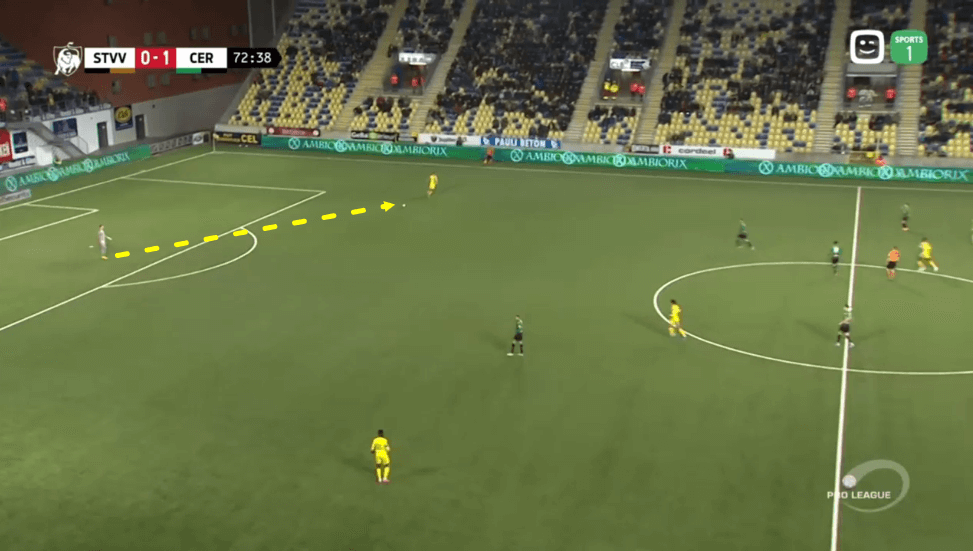
We can see an example of De Smet performing his role in the build-up in this image above. Here, the left-back is his side’s deepest player. He collects the ball from the goalkeeper before carrying it forward in order to advance to the midfield.
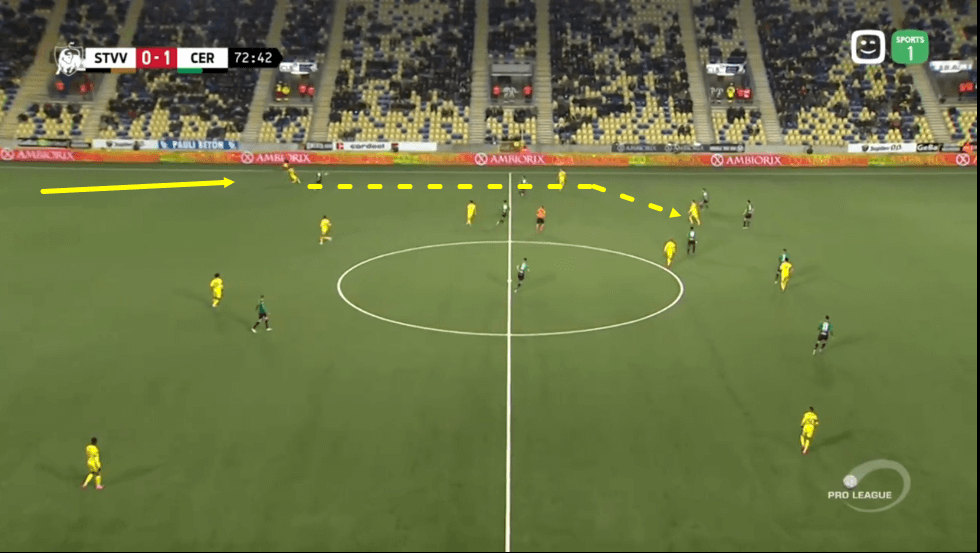
As play moves on, De Smet does attract an opposition player’s press, however, he acts fairly calm under pressure and isn’t put off attempting the pass that he had intended, which is a long-ball over the midfield in search of his teammate who we can see occupying Sint-Truidense’s left half-space here.
This passage of play provides us with an example of what De Smet’s role was in the build-up last term and this may show us where his strengths lie during this phase of play.
The new Reims man isn’t as good of a dribbler as Kamara is, however, he may be a better passer and as a result, he may be more useful as someone to help Reims progress the ball from the back to the midfield, rather than someone to help them progress from the midfield to the attack, like Kamara was last term.
While De Smet’s dribbling stats didn’t look very impressive compared to Kamara’s for the 2019/20 campaign, his passing stats draw a much more favourable comparison.
Reims’ new left-back made 0.74 more long passes per 90, 1.92 more passes to the final third per 90 and 2.52 more forward passes per 90 than Kamara in the 2019/20 campaign and with that in mind, perhaps Guion will alter his tactics for the coming season to see the left-back play a slightly different role, in order to accommodate De Smet’s strengths in the early part of the build-up.
De Smet out of possession
The previous section makes it clear that De Smet differs significantly from Kamara in possession, however, the two full-backs are much more comparable out of possession and this may give us an indication of what it was about De Smet that attracted Reims to the Sint-Truidense man in the first place.
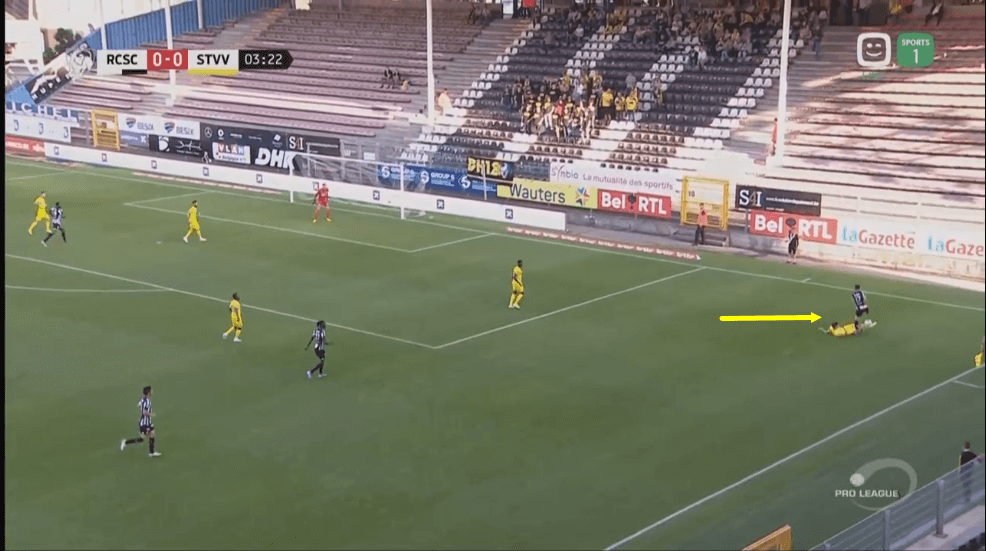
De Smet doesn’t tend to go to ground as much as Kamara, who makes a very high number of slide tackles, however, the new Reims man is an aggressive defender in a similar fashion to Kamara and he actually engaged in slightly more defensive duels per 90 than Kamara did during the 2019/20 campaign.
The Belgian also made just slightly fewer interceptions per 90 than Kamara did last term, however, the two defenders’ defensive numbers were generally very similar last season, indicating that the two do share some common ground on the defensive side of the game.
Firstly, while he goes to ground much less than Kamara, De Smet is happy to commit to sliding tackles when necessary, as demonstrated in the image above. De Smet rarely commits to sliding tackles high up the pitch, which is an area in which he differs from Kamara, who can often be seen going to ground high up the pitch.
Instead, the Belgian prefers to reserve his sliding tackles for when he is defending in a deeper area of the pitch. The 22-year-old often goes to ground if an opposition player gets past him on the wing or is played in behind him. He uses his pace to make up the ground on the ball-carrier before making a last-ditch sliding tackle. De Smet is also comfortable with committing fully to 50/50 challenges in deeper areas of the pitch and he has been seen going to ground in order to contest those sorts of challenges.
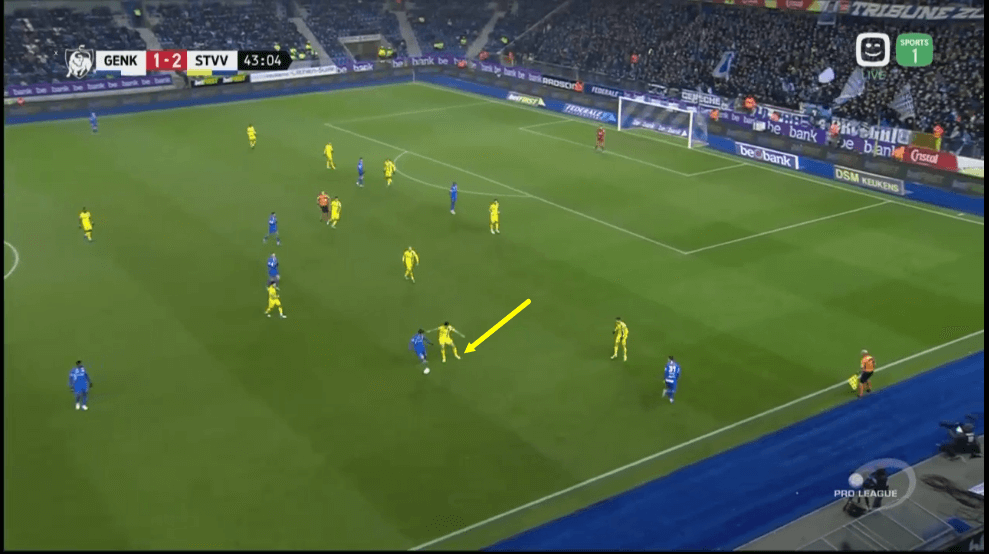
While he doesn’t tend to go to ground high up the pitch, De Smet does like to defend aggressively in advanced areas of the pitch, as we can see in this image above.
Here, De Smet has vacated his position in the backline in order to aggressively press the opposition ball-carrier, however, instead of going to ground once he is within touching distance of the player, De Smet stays on his feet the whole time, simply standing the player up and forcing him backwards via his pressing rather than actively trying to take the ball from him immediately.
De Smet likes to defend on his feet in more advanced areas of the pitch. He likes to defend high and aggressively and we can see that he is placed in a more advanced position than the majority of his teammates here, however, when he does defend high, he likes to stand the opponent up and try to force them to make a mistake, as opposed to trying to force the ball away from them more directly.
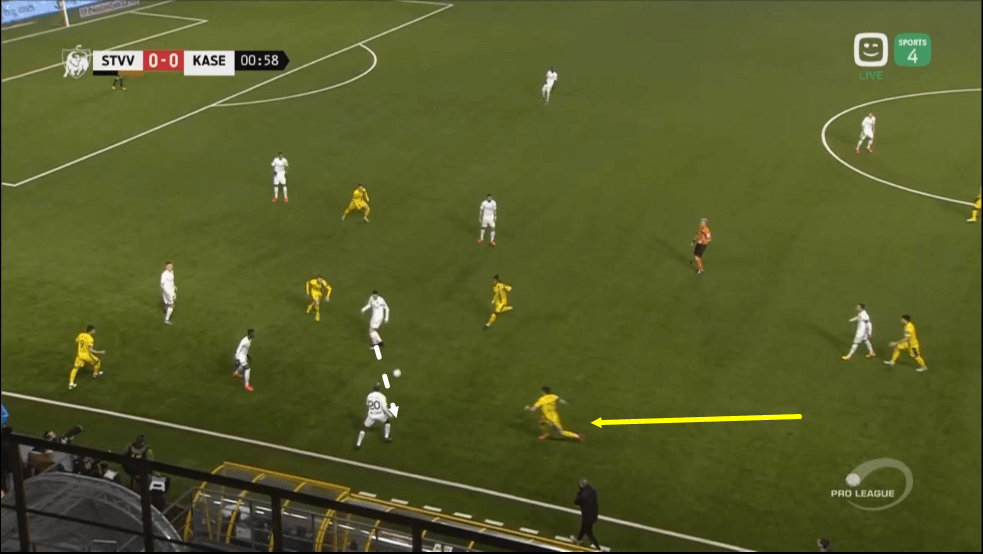
De Smet’s pace and anticipation are important when defending high up the pitch, as we can see in this next image.
Here, the opposition wide man is waiting to receive a quick, short pass from a more central player, however, De Smet is quick to pounce as soon as that pass is played and as soon as this wide man receives possession of the ball, he loses it thanks to a well-timed and quick press from the left-back who performs an effective standing challenge.
This is an area that De Smet thrives in when the opposition are attempting to build from the midfield. The new Reims man has shown himself to be a good reader of the game, similar to Kamara, and that trait, combined with his pace, may help him to slot in well as a replacement for Kamara off the ball.
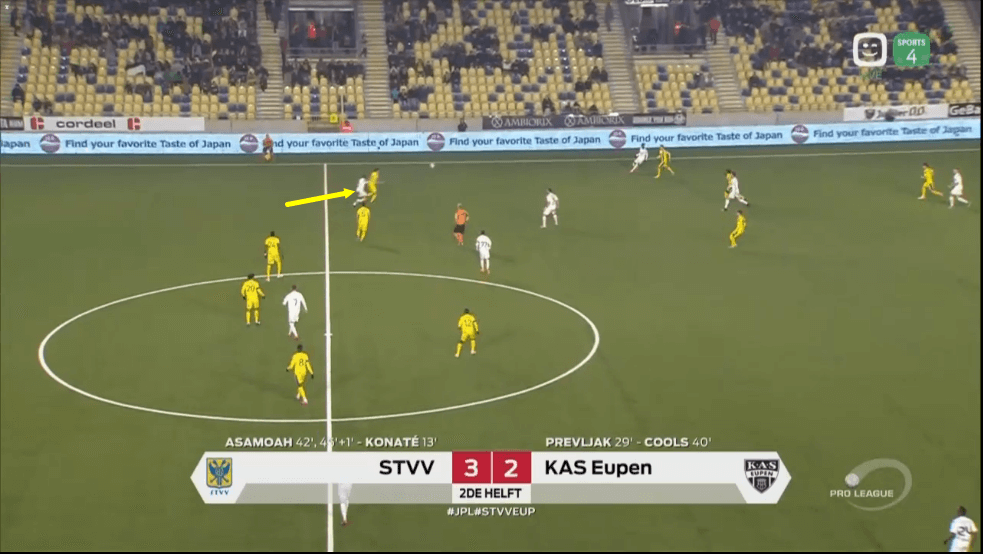
As far as his interceptions go, again, his pace and reading of the game come in useful here and as he posted similar numbers to Kamara in this area last term, perhaps it may be fair to say that he has the potential to fill the former Reims man’s boots in this area of the game.
De Smet can often be seen checking his surroundings and making himself fully aware of where all opposition players are positioned and that was certainly the case in this particular scenario.
Here, the opposition attempted to play a ball from deep up to a player positioned high and slightly on the right-hand side of the pitch. De Smet checks his surroundings multiple times before the ball is played, before positioning himself accordingly and essentially greeting the attempted pass quote happily without much trouble.
Conclusion
To conclude this tactical analysis piece, we believe that De Smet may not fit perfectly into the exact role that Kamara played for Reims last season and if that’s what’s expected of him, then he may struggle, however, it may be understandable why Reims targeted the Sint-Truidense man as a Kamara replacement, considering the two players’ similarities off the ball, and if the club can adjust slightly in terms of their expectations from the left-back on the ball in order to accommodate De Smet, he may not be a bad signing for Reims.




Comments